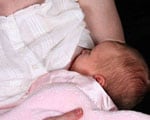Infants whose mothers had diabetes during pregnancy are at a higher risk for childhood obesity, but breast-feeding lowers that risk.

Children born to mothers with diabetes during pregnancy have been shown to have a greater prevalence of obesity in childhood. These youth may be programmed in utero for later development of obesity by exposure to excess maternal glucose (and other fuels) at a critical period of development. The relationship between breastfeeding and long-term obesity risk has been extensively studied, and breastfeeding is now promoted as an important prevention strategy with considerable public health bene?ts. The macronutrient composition of breast milk (i.e., protein, fat, carbohydrate) and bioactive substances not present in formula may in?uence metabolic programming and regulation of body fatness and growth rate. Higher insulin levels and lower leptin levels have been reported in formula-fed infants compared with breast-fed babies. The effect of breastfeeding on infant growth may be an important determinant of early life programming for future obesity and chronic disease, especially for the offspring of diabetic pregnancies. However, the question of whether breastfeeding may actually reduce the risk of future obesity conferred by fetal over nutrition, as marked by exposure to diabetes in utero, is inconclusive.
To evaluate whether breastfeeding lowers the chances of childhood obesity resulting from exposure to diabetes in utero, researchers followed 89 American children exposed to diabetes in utero and 379 unexposed youth and got details like BMI, waist circumference, skin fold thickness, abdominal fat etc. A measure of breast milk - months was derived from maternal self-report and used to categories breastfeeding status as low (<6) and adequate (=6 breast milk - months). Exposed and unexposed offspring were not signi?cantly different in terms of intrauterine growth and socioeconomic factors or infant feeding practices.
Both exposed and unexposed youth who had adequate breastfeeding had signi?cantly lower BMI, waist circumference, skin fold thickness and abdominal fat at ages 613 years than those with less than 6 breast milkmonths. It was found that among babies exposed to diabetes in utero, those who were breast-fed for six months or more were no more likely to put on extra weight when they were 6 to 13 years old than children whose mothers did not have diabetes during pregnancy. The findings were the same across all ethnicities. However, this protective effect was not seen in babies who were breast-fed for less than six months.
The study provides evidence that the effect of exposure to diabetes in utero on childhood adiposity parameters is substantially attenuated by breastfeeding. Since childhood obesity and in utero exposure to maternal diabetes have both been associated with later development of type 2 diabetes, it follows that breast-feeding these children may also help reduce their future risk for developing type 2 diabetes. The findings suggest that breastfeeding promotion may be an effective strategy for reducing the increased risk of childhood obesity in the offspring of mothers with diabetes during pregnancy. However, further research would be needed to confirm that added protection.
DoctorNDTV is the one stop site for all your health needs providing the most credible health information, health news and tips with expert advice on healthy living, diet plans, informative videos etc. You can get the most relevant and accurate info you need about health problems like diabetes, cancer, pregnancy, HIV and AIDS, weight loss and many other lifestyle diseases. We have a panel of over 350 experts who help us develop content by giving their valuable inputs and bringing to us the latest in the world of healthcare.












